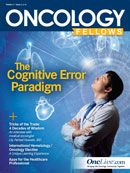International Hematology/Oncology Elective: A Unique Learning Experience
Although minor institution-specific variations exist, traditional fellowship programs in the United States are able to provide training in the sophisticated Western style of practice.
Dr Akshat Jain (far right) during his research initiative in India
Although minor institution-specific variations exist, traditional fellowship programs in the United States are able to provide training in the sophisticated Western style of practice. Given the increasing prevalence of international immigration, however, it behooves all trainees to be culturally competent in dealing with patients from other countries.
Globally, the burden of cancer continues to grow. Nearly 14.1 million new cancer cases and 8.2 million cancer-related deaths occurred in 2012. These data reflect increases from 2008 data, which revealed that approximately 12.7 million people were diagnosed and 7.6 million died of cancer.1,2
In the United States alone, cancer is the second-most common cause of death.3 Epidemiological evidence points to the emergence of a similar trend in developing countries. For instance, cancer and cancer-related complications are emerging as recognized major public health problems in developing countries such as India.1,2,4,5
As of 2012, the estimated number of new cancer cases in India was approximately 1 million. Nearly 700,000 people (17% of the global population) died of the disease. Due to an aging population, cancer burden rates are projected to rise to nearly 1.7 million deaths per year by 2035.1
Despite data that reveal that cancer mortality rates are decreasing in more developed countries, in resource-limited countries such as India,1 physicians face a multitude of compliance issues and societal factors that often lead to treatment failure.
The World—A Level Playing Field
After growing up in Asia, receiving medical training in Africa and the United States, and running my medical nonprofit organization, I began to see the larger picture—the “global picture.”
There are people dying of cancer and blood-related disorders around the world, and the healthcare systems in place to deal with these diseases differ widely from the healthcare system here in the United States.
As a senior fellow, I mentored a third-year medical student who visited India for a hematology/oncology rotation that went smoothly. It was time for me to take the plunge. I was curious to learn firsthand how a country of nearly 1.2 billion people6 handles its cancer care—a trip was in order.
Research Initiative
I piloted a needs assessment project in rural India to assess the barriers that patients face when seeking continuing care for cancer once discharged from initial induction therapy. The clinical and research goals of my elective (Figure) were guided by the core competencies of the Accreditation Council for Graduate Medical Education7:
- Patient Care
- Medical Knowledge
- Practice-Based Learning and Improvement
- Professionalism
Based on my assessment, I identified the need to tackle cancer and improve patient care via more cost-effective approaches, including planned interventions and the establishment of partnerships.
Over the course of my trip, I witnessed health policy in action. During a rural health visit deep into the pockets of the desert state of Rajasthan, my colleagues and I were offered a cooked meal that was made from government-issued iron-fortified food products. I witnessed the success of this program, which is similar to other national programs that cater to over a billion people.
I also quickly learned that differences between the rural and urban settings, including political differences, can make it challenging to formulate predictions that are broadly applicable. Based on my experiences, the most commonly affected patients live in rural areas and travel to urban areas for treatment.
While working closely with the team at Sawai ManSingh Medical College, I witnessed challenging stem cell transplantation procedures in 2 patients with life-threatening aplastic anemia. This was the first time that the stem cell transplant division would perform this particular procedure. Learning about the design of the conditioning regimen, donor selection, and antibiotic prophylaxis was an eye-opening experience for me. These procedures were performed for a fraction of what they would have cost in the United States, and the outcomes were comparable, if not better, with full engraftment by the third week and no signs of graft-versus-host disease.
Overall, this international elective was a very valuable learning experience, as I became more culturally competent. I recommend that others pursue similar opportunities if possible, to gain a comprehensive picture of cancer care.
My elective has since developed into a career. To learn more about my work with Project AGNI, please visit http://dostakshat.wix.com/akshat-jain, or contact me at ajain12@nshs.edu.
Akshat Jain, MD, MPH, is a senior hematology/oncology and stem cell transplantation fellow at the Steven and Alexandra Cohen Children’s Medical Center of New York.
References
- Mallath MK, Taylor DG, Badwe RA, et al. The growing burden of cancer in India: epidemiology and social context. Lancet Oncol. 2014;15(6):e205-e212.
- The International Agency for Research on Cancer. Latest world cancer statistics: global cancer burden rises to 14.1 million new cases in 2012: marked increase in breast cancers must be addressed. http://www.iarc.fr/en/media-centre/pr/2013/pdfs/pr223_E.pdf. Published December 12, 2013. Accessed May 12, 2014.
- American Cancer Society. Cancer facts & figures 2014. http://www.cancer.org/acs/groups/content/@research/documents/webcontent/acspc-042151.pdf. Published 2014. Accessed May 12, 2014.
- Mathew A, Varghese C, Nair MK. Estimating cancer survival in developing countries: use of reply-paid post cards to augment follow-up information. Indian J Cancer. 1999;36(2-4):91-98.
- Gajalakshmi CK, Shanta V. Methodology for long term follow-up of cancer cases in a developing environment. Indian J Cancer. 1995;32(4):160-168.
- India’s population 2013. IndiaOnlinePages.com website. http://www.indiaonlinepages.com/population/india-currentpopulation.html. Accessed May 7, 2014.
- Summative evaluation of competencies for 12-month clinical phase residents: global resident competency rating form. Accreditation Council for Graduate Medical Education website. https://www.acgme.org/acgmeweb/Portals/0/PFAssets/ProgramResources/380_SummativeEvaluation_GPM_AA_04_10_2008.pdf. Accessed May 12, 2014.




